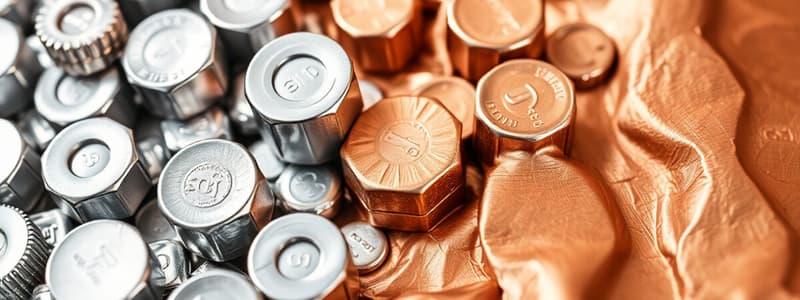Podcast
Questions and Answers
Which of the following metals is known for being lightweight and can be MIG and TIG welded?
Which of the following metals is known for being lightweight and can be MIG and TIG welded?
- Aluminium (correct)
- Copper
- Titanium
- Gold
Zinc has a melting temperature of 420C.
Zinc has a melting temperature of 420C.
True (A)
What is one use of copper?
What is one use of copper?
Electrical wire
______ is a non-ferrous metal commonly used for jewellery and has a melting temperature of 960C.
______ is a non-ferrous metal commonly used for jewellery and has a melting temperature of 960C.
Match each non-ferrous metal with its primary usage:
Match each non-ferrous metal with its primary usage:
Flashcards are hidden until you start studying
Study Notes
Non-Ferrous Metals Characteristics
- Non-ferrous metals are known for their ductility, malleability, corrosion resistance, and ability to conduct electricity and heat.
Aluminium
- Lightweight material commonly used in various industries.
- Can be welded using Metal Inert Gas (MIG) and Tungsten Inert Gas (TIG) techniques.
- Melting temperature is 660°C.
- Common applications include drinks cans, aircraft bodies, and baking foil.
Copper
- Notable for its toughness and high conductivity.
- Versatile; can be soldered or brazed.
- Melting temperature is 1080°C.
- Widely used in electrical wiring and water pipes.
Zinc
- Melting temperature is relatively low at 420°C.
- Primarily used for galvanizing steel, protecting items like dustbins and buckets.
Silver
- Can be soldered, enhancing its versatility in jewelry making.
- Melting temperature is 960°C.
- Commonly utilized in jewelry and cutlery manufacturing.
Gold
- Another metal that can be soldered.
- Melting temperature is 1060°C.
- Frequently used in jewelry and electronic switch components due to its excellent conductivity.
Titanium
- Known for its hardness and lightweight properties.
- Malleable at high temperatures, facilitating various applications.
- Melting temperature is 1670°C.
- Used in medical applications like tooth implants and high-performance bicycles.
Tin
- Has a low melting temperature of 230°C.
- Mostly applied as a coating for food cans to prevent corrosion.
Studying That Suits You
Use AI to generate personalized quizzes and flashcards to suit your learning preferences.




